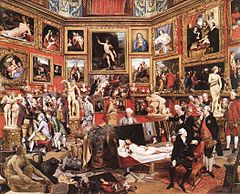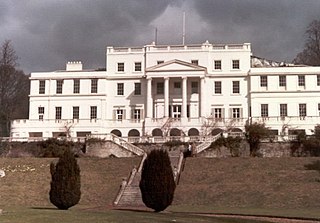
Sir Horace (Horatio) Mann, 1st Baronet KB (8 August 1706 – 6 November 1786), was a long-standing British resident and diplomat in Florence.


Sir Horace (Horatio) Mann, 1st Baronet KB (8 August 1706 – 6 November 1786), was a long-standing British resident and diplomat in Florence.

Mann was the second son of Robert Mann (1678–1751), a successful London merchant, and his wife, Eleanor Guise Mann. He was baptised at St Martin's in the Fields, Middlesex, on 22 August 1706, brought up in Chelsea, and educated at Eton College and later, briefly, at Clare College, Cambridge. [1] Suffering from poor health, he travelled on the continent in the 1730s.
In February 1737, he was appointed as secretary to Charles Fane, the British Minister at Florence. [2] He then served as British diplomatic representative there to the Grand Dukes of Tuscany for the rest of his life.
In the course of his long diplomatic career, he was Chargé d'affaires in 1738-1740; Minister between 1740 and 1765; Envoy Extraordinary from 1767; and finally Envoy Extraordinary and Plenipotentiary from 1782 until his death. [3]
As Great Britain had no diplomatic representation at Rome, Mann's duties included reporting on the activities of the exiled Stuarts, the Old Pretender and the Young Pretender. [2]


Mann kept an open house for British visitors at Palazzo Manetti, Florence, inviting them for conversazione when there was no performance at the theatre. His generosity and kindness was well known, [5] although his close friendship with the painter Thomas Patch (expelled from Rome after a homosexual incident) reflected on his reputation. [6] He met Horace Walpole (to whom he was distantly related [7] ) in 1739, and conducted a now-renowned correspondence with him over forty years, though they last met in 1741. The correspondence was published by Lord Dover in 1833. [2]
In recognition of his service he was created a baronet on 3 March 1755, [8] and made a Knight of the Bath on 26 October 1768, [2] (when his nephew Horace stood proxy). [6] In 1775, on the death of his elder brother, Edward Mann, Horace Mann inherited the Linton Park estate which his father had bought in Linton, Kent. [2]
Mann, a lover of Horace Walpole, [9] died unmarried in Florence on 6 November 1786 and was buried in Linton on 17 February 1787. His nephew, Horace, inherited his baronetcy by special remainder and also acted as Chargé d'affaires until the arrival of his replacement. [3]

Horatio Walpole, 4th Earl of Orford, better known as Horace Walpole, was an English writer, art historian, man of letters, antiquarian, and Whig politician.

Charles Townshend, 2nd Viscount Townshend, was an English Whig statesman. He served for a decade as Secretary of State for the Northern Department from 1714 to 1717 and again from 1721 to 1730. He directed British foreign policy in close collaboration with his brother-in-law, prime minister Robert Walpole. He was often known as Turnip Townshend because of his strong interest in farming turnips and his role in the British Agricultural Revolution.

John Perceval, 2nd Earl of Egmont was a British politician, political pamphleteer, and genealogist who served as First Lord of the Admiralty. Of Anglo-Irish background, he sat in both the Irish and British Parliaments. He was the father of the Regency Era Prime Minister Spencer Perceval.

Robert Hampden-Trevor, 1st Viscount Hampden was a British diplomat at The Hague and then joint Postmaster General.

Earl Cowper was a title in the Peerage of Great Britain. It was created in 1718 by George I for William Cowper, 1st Baron Cowper, his first Lord Chancellor, with remainder in default of male issue of his own to his younger brother, Spencer Cowper. Cowper had already been created Baron Cowper of Wingham in the County of Kent, in the Peerage of England on 14 December 1706, with normal remainder to the heirs male of his body, and was made Viscount Fordwich, in the County of Kent, at the same time as he was given the earldom, also Peerage of Great Britain and with similar remainder. He was the great-grandson of William Cowper, who was created a Baronet, of Ratling Court in the County of Kent, in the Baronetage of England on 4 March 1642. The latter was succeeded by his grandson, the second Baronet. He represented Hertford in Parliament. He was succeeded by his eldest son, the aforementioned William Cowper, the third Baronet, who was elevated to the peerage as Baron Cowper in 1706 and made Earl Cowper in 1718. In 1706 Lord Cowper married as his second wife Mary Clavering, daughter of John Clavering, of Chopwell, County Durham.

Sir Horatio (Horace) Mann, 2nd Baronet was a British politician who sat in the House of Commons between 1774 and 1807. He is remembered as a member of the Hambledon Club in Hampshire and a patron of Kent cricket. He was an occasional player but rarely in first-class matches.
Horace Mann (1796–1859) was an American education reformer.

Thomas Pitt, 1st Baron Camelford was a British politician who sat in the House of Commons from 1761 until 1784 when he was raised to the peerage as Baron Camelford. He was an art connoisseur.

Catherine, Lady Walpole was the first wife of the first British prime minister Sir Robert Walpole.

James Cornwallis, 4th Earl Cornwallis was a British clergyman and peer.
There have been two baronetcies created for persons with the surname Mann, one in the Baronetage of Great Britain and one in the Baronetage of the United Kingdom.

George Walpole, 3rd Earl of Orford, was a British administrator, politician, and peer.

George Nassau Clavering-Cowper, 3rd Earl Cowper was an English peer who went on the Grand Tour as a young man, but actually emigrated. Despite becoming a member of parliament and later inheriting lands and the title of Earl Cowper in England, he remained in Italy. He amassed a valuable art collection and became a Prince of the Holy Roman Empire. He was a patron of the arts and science.

Linton Park, formerly Linton Place or Linton Hall, is a large 18th-century country house in Linton, Kent, England. Built by Robert Mann in 1730 to replace a much earlier building called 'Capell's Court', the estate passed through the ownership of several members of Mann's family before coming into the Cornwallis family. The house was enlarged to its current size in 1825.

Margaret Rolle, 15th Baroness Clintonsuo jure, was a wealthy British aristocrat, known both for eccentricity and her extramarital affairs.

Alexander Murray of Elibank was the fourth son of Alexander Murray, 4th Lord Elibank and brother of Patrick Murray, 5th Lord Elibank. Horace Walpole said that Murray and his brother were "both such active Jacobites, that if the Pretender had succeeded, they could have produced many witnesses to testify their zeal for him; both so cautious, that no witnesses of actual treason could be produced by the government against them".
Notes
Bibliography